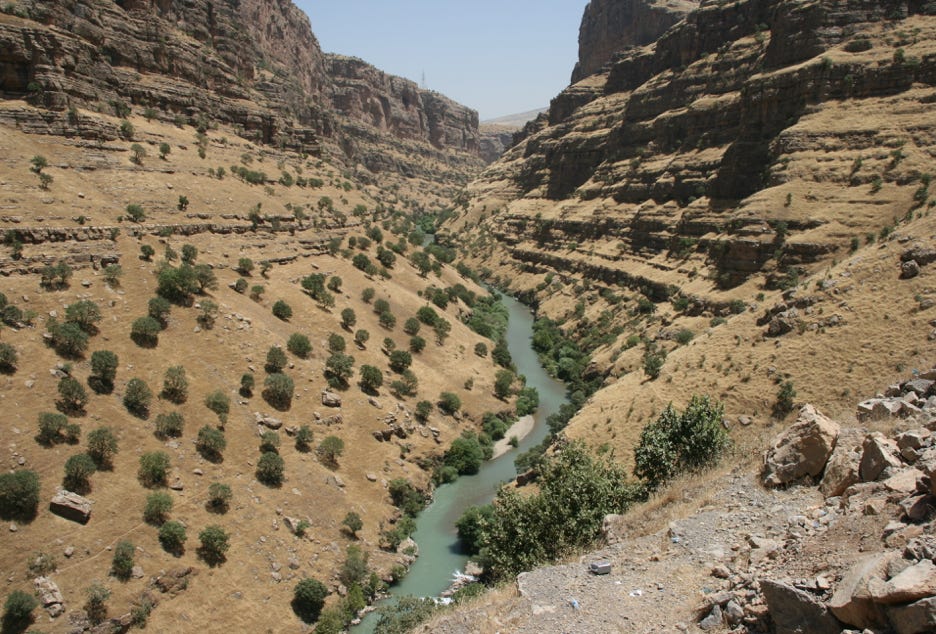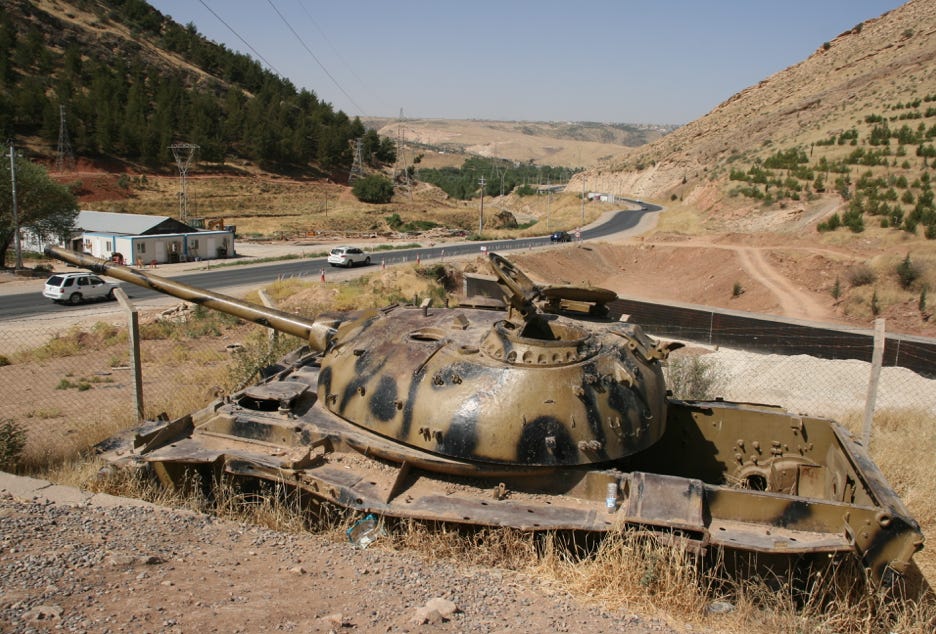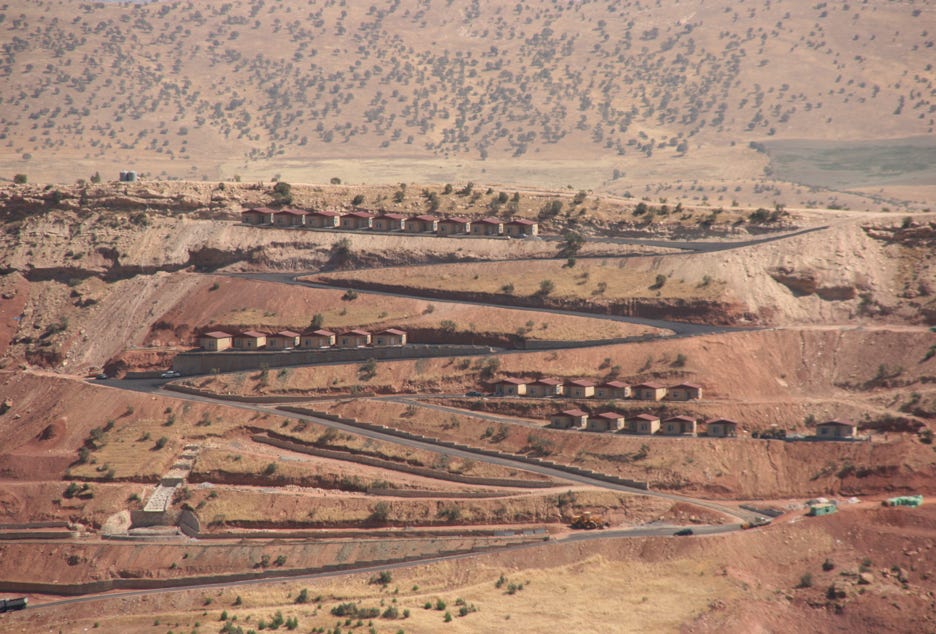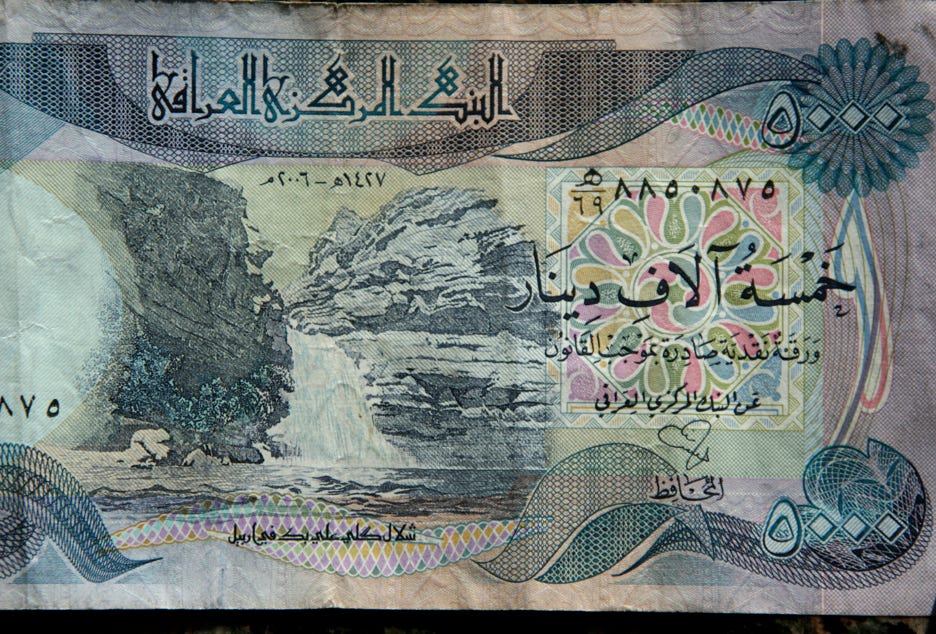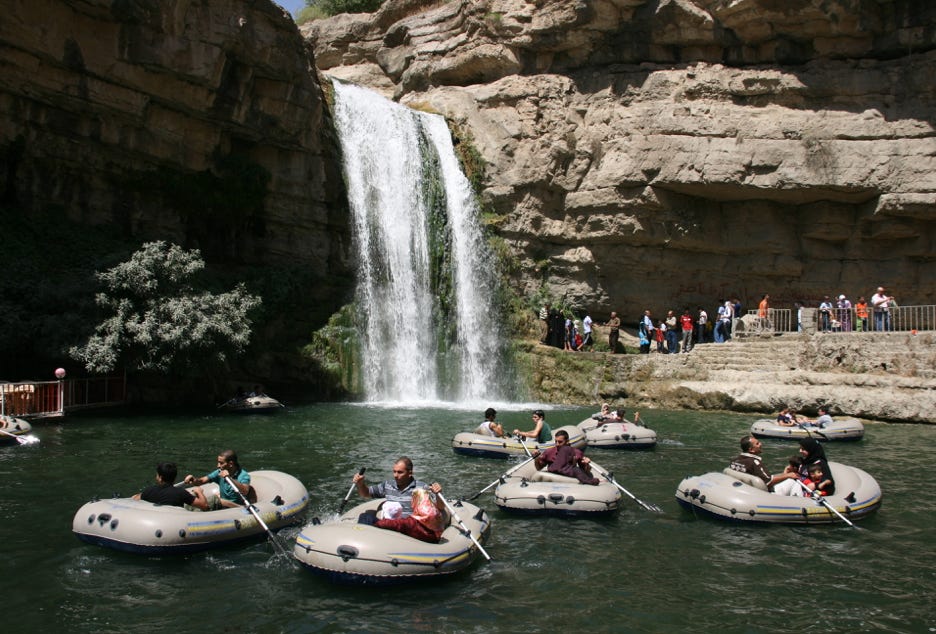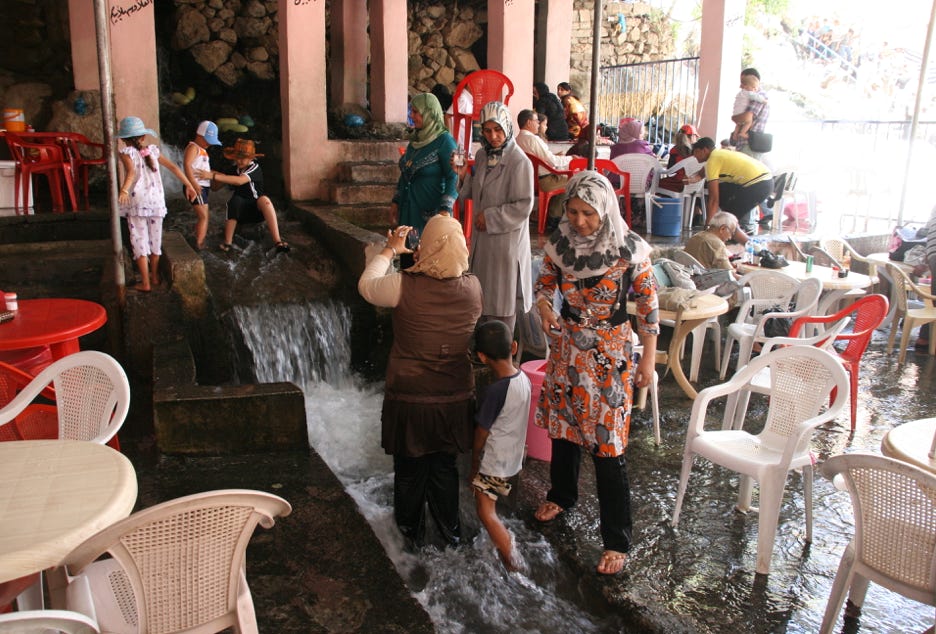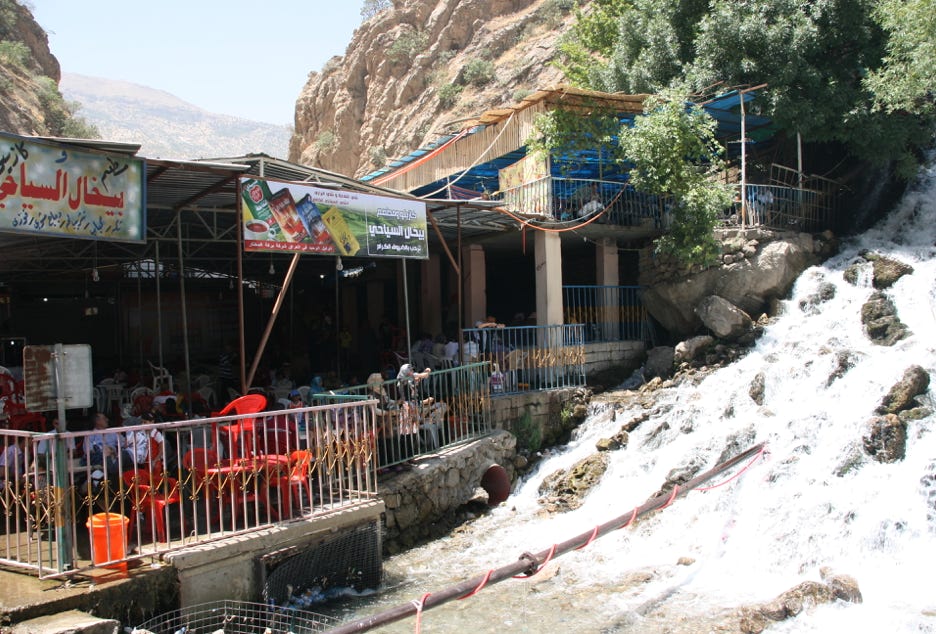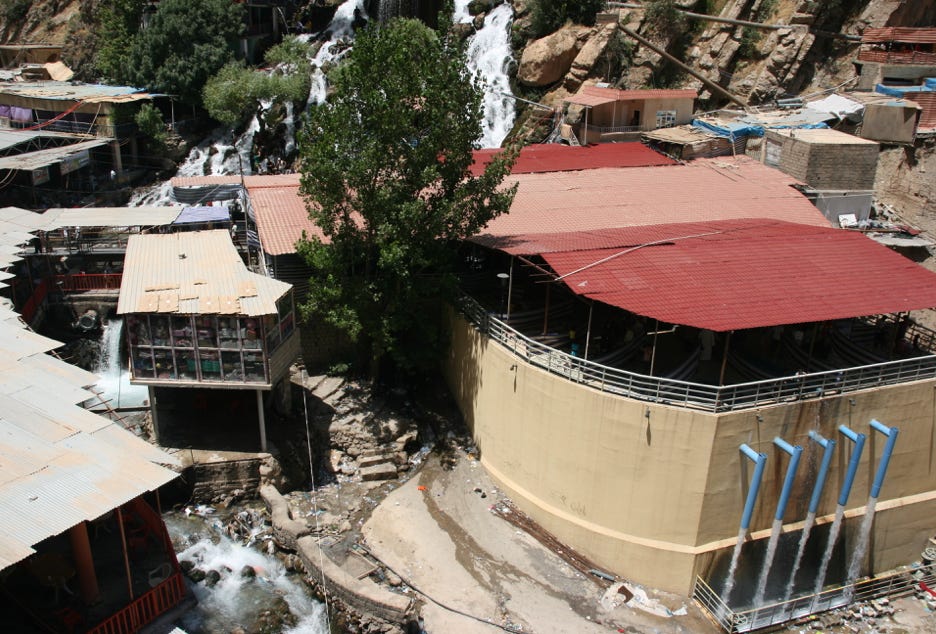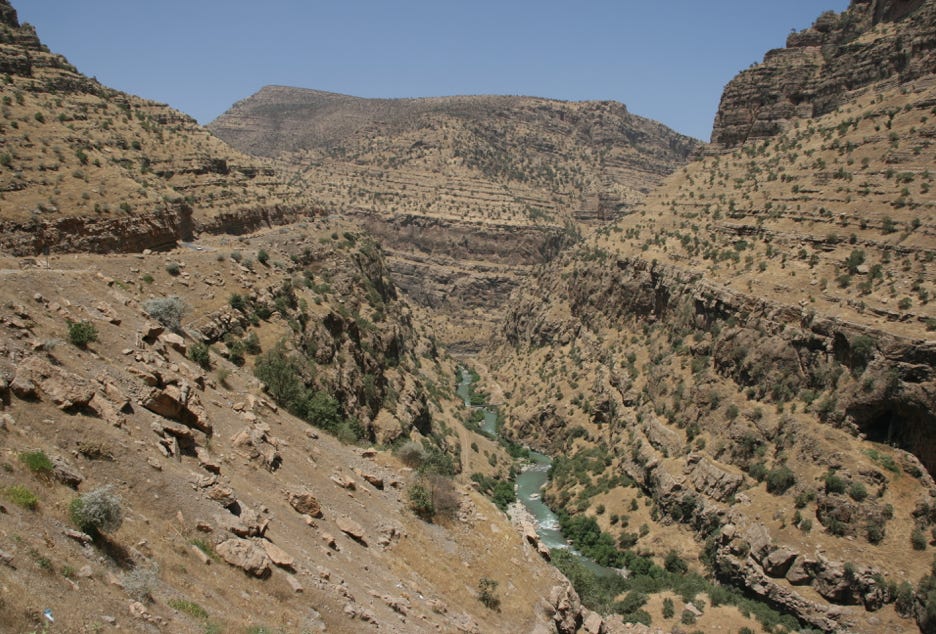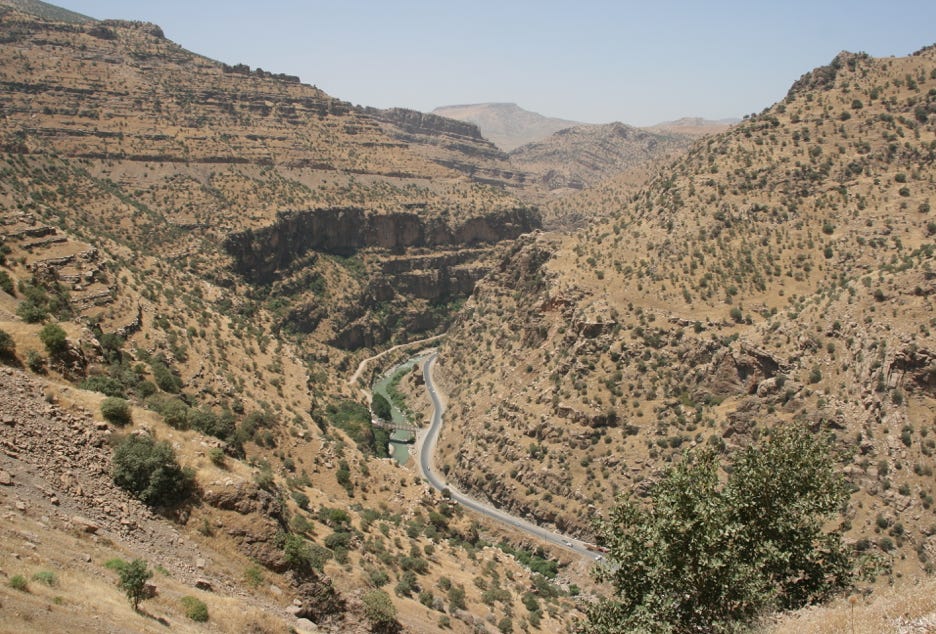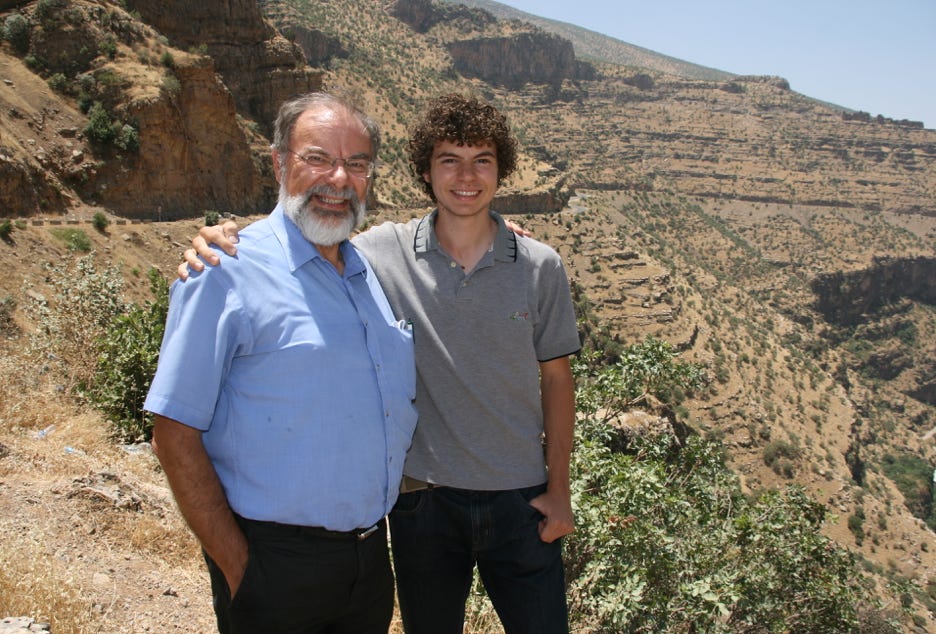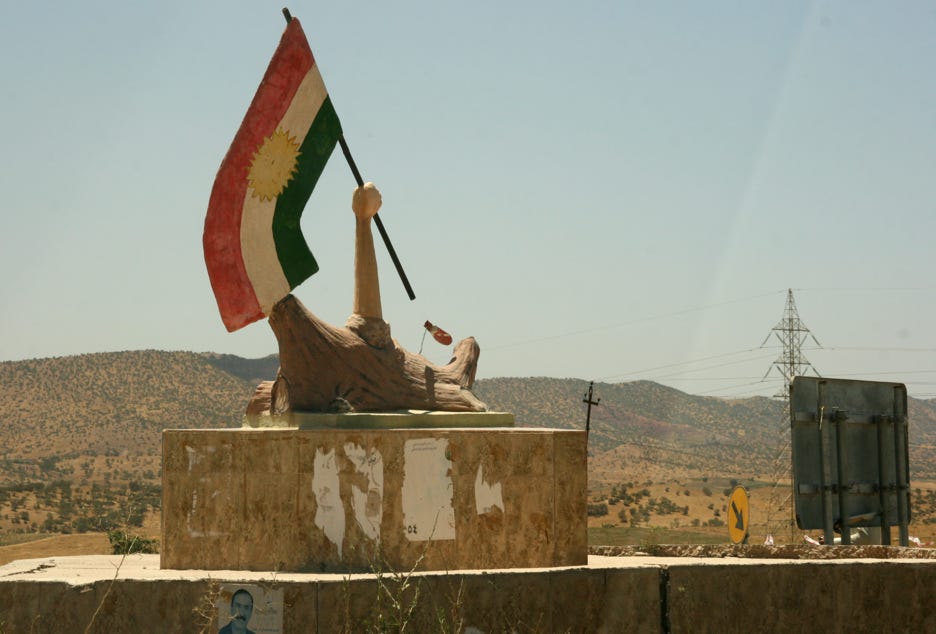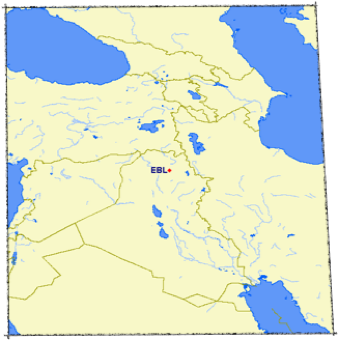
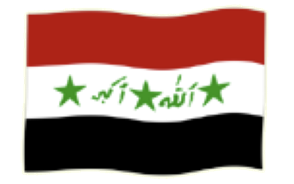

Our main intention today was to see something of the countryside, towns and villages in Iraqi Kurdistan. With that in mind, we found a taxi driver who was prepared to take us about 100 kilometres north-east of Erbil to Gali Ali Beg Gorge and part of the Hamilton Road that was built between 1928 and 1932 under the guidance of New Zealand engineer Sir Archibald Milne Hamilton to link Erbil with the Iranian border.
We left the hotel at 8 am in attempt to avoid the oppressive heat that we knew would arrive later in the day; it was supposed to be a sunny 45°C in Erbil today. We made just one short stop on the way at a point where three damaged tanks were displayed beside the road, remnants of a battle in 1991 between Saddam Hussein’s government forces and Kurdish rebels. As the fading pantings on a concrete stand beneath the tanks testify, the Kurds won.
The drive from Erbil began in flat, fairly monotonous country, but as we approached the Gorge, steep mountains began to appear with small villages nestled into the valleys. After about two and a half hours of driving we arrived at Gali Ali Beg Waterfall, which – depending on which way you are travelling – marked the start of the Gorge (if you were driving up into the mountains to Iran) or the end of the Gorge (if you were a molecule of water flowing in the Great Zab River).
I had an idea what the waterfall would look like because it is prominently featured on Iraq’s 5000 Dinar note (worth about US$4). However, the reality was quite different. Rather than the wilderness experience I had anticipated, there were hundreds of tourists (mainly Arabic speaking Iraqis from Baghdad) who had come to Kurdistan to escape the summer heat of the south. Interesting note; come to a place where the temperature is a refreshing 45°C to escape the home temperatures of 52°C! Couples and families were rowing in inflatable boats, people were standing under the waterfall to get cool, hundreds of photos were being taken, and a multitude of small, concrete-floored open-sided restaurants were doing a roaring trade in cool drinks.
We continued our drive along the Lower Hamilton Road until we reached Rawanduz, at which point the Upper Hamilton Road meets the lower road. We therefore took the Upper Road to a second waterfall, the Bekhal Waterfall. At Bekhal, the water seems to emerge from a point in the cliff face in a huge torrent down several stepped layers of rocks and then across the floors of tens of little restaurants that have been built IN the waterfall. This was a fascinating example of developing a natural resource into a tourist attraction, and it it was attracting tourists in their hundreds. The effect of being under cover in an area where the water is flowing across the floor with a breeze blowing through was indeed refreshing; the sensation was similar to being in front of an under-powered air conditioner.
So, while parents were sipping cool drinks at tables and chairs set on concrete floors with a film of water flowing across them, their children were happily splashing around in deeper canals that had been constructed in the concrete floors. This must be the most over-developed waterfall I have ever seen.
Our drive along the Upper Hamilton Road provided us with some wonderful views of the Gali Ali Beg Gorge. Gali Ali Beg Gorge has been described as the Grand Canyon of the Middle East, and while that claim may be an example of similar hyperbole that compares Erbil’s economic development with that of Dubai, it certainly was a very impressive sight and well worth the drive.
Upon returning to Erbil, we had some business to attend to, namely going to the airport to collect our missing bags that we were told had arrived on the early morning flight. This turned out not to be the simple task I had hoped for. Our taxi (like all vehicles) had to park in an area outside the perimeter fence. In order to get into the airport compound, we had to pass through full security (removing watches, belts, phones, wallets, etc), and having sone so, they would only allow one of us to go to the terminal to collect the bags. I elected to go, which meant I needed a visitor’s badge, in return for which they kept Andrew’s passport, and Andrew.
Thus alone, I caught the official minibus that takes all passengers to the terminals, and approached the Arrivals Terminal where I was told our luggage was waiting for us. The only way in was through the exit door, but when I explained I was there to collect lost luggage and showed the badge and documents, I was permitted to enter. The lost luggage section was a sad looking collection of bags out in the open in one corner of the Arrivals Hall, right next to one of the conveyor belts that delivers luggage to passengers. A thorough search (which took about 15 seconds) revealed the sad fact that although my suitcase had arrived, Andrew’s had not.
Nonetheless, I had to complete the paperwork to acknowledge that my bag was being taken – this comprised sticking the luggage tag in a book, next to which the “Lost and Found Officer” wrote a seemingly random collection of consonants that was intended to resemble my name in some vague manner. In what seemed like a déja vue experience of our arrival in Erbil two nights previously, I was then directed to report to the Royal Jordanian Airlines office over in the Departures Terminal.
To get to the Departures Terminal, I had to have my suitcase X-rayed by the security officers. They seemed concerned about something that showed up on the X-ray and asked me to open the suitcase. Of course, I was not able to do so because my keys were back in the hotel room. They replied by saying that they would cut open the lock, to which I replied that this would be fine provided they gave me a replacement lock. They said they never did this. I said I was flying out that night and would not have time to find a replacement lock, and reminded them it was against the regulations to send check-in bags unlocked. There was more chat back and forth, and eventually, thankfully, I was just given the “sweeping you away” gesture of the hand.
To enter the Departures Terminal I had go through the full security clearance again (removing watch, belt, phone, wallet, etc), although this time my suitcase was also included in the search. I was asked what my destination was, and I replied honestly with a point of the finger “the Royal Jordanian Airlines Office just over there”. But there was a problem. When I arrived, the office was closed. So I phoned the number on the door, and spoke to a particularly unhelpful person in Baghdad who just kept saying “it’s no problem”.
“My bag arrived, but my son’s did not”. The reply: “It’s no problem.”
“Well, it is a problem because he has not changed his clothes for four days.” The reply: “It’s no problem.”
“It is a problem to him! More to the point, we fly out tonight and we do not have his bag.” The reply: “It’s no problem, it might come tonight.”
“But if it comes tonight, it will arrive at 3 am. We have to check in by 2 am because the flight leaves at 4 am.” The reply: “It’s no problem. The bag might not be on the 3 am flight. So you can check in at 2 am.”
I felt I was reaching the limits of helpfulness of the officer in question, at which point I was given another phone number to try later. So I cleared security to get out of the building (removing watch, belt, phone, wallet, etc), caught the minibus for the one kilometre journey back to the guard house at the perimeter fence, cleared security again to get into the guard house (removing watch, belt, phone, wallet, etc), and found Andrew who, not unreasonably, was wondering where I had been – and more to the point, why I had returned with only one suitcase; one that was not his!
I had to be the bearer of disappointing news - there was little likelihood of adding to the variety of clothes he would be wearing in photos for the next few days, just as the last few days had been fairly uniform.
We both wanted to send some postcards from Iraq to friends and relatives, so the taxi driver helpfully offered to take us to some stationary shops that stocked them. But they didn’t. So we drove to some art shops that we were told definitely sold them. They didn’t either. However, we had seen a few postcards of random far away areas in Kurdistan (none related to anything within hundreds of kilometres of places we had actually seen) in a small shop in the Citadel when we visited yesterday. So in desperation to find postcards, we returned to the shop, and bought a packet.
With at least some sense of achievement, we returned to the hotel. To our surprise, the Manager of the Royal Jordanian Airlines office in Erbil was sipping coffee near the Reception Desk, so we relayed the problem with Andrew’s luggage.
“It’s no problem. We have no idea where is the luggage. The computers have no messages about it. The scanning says it went to Erbil, but it is not here. Maybe it did not go to Erbil. Maybe someone took it. It happens. We are checking security cameras. But it’s no problem because we always find the luggage and send it to you”.
Reassured by this, he promised to be in his office in the Departures Terminal at 2 am tonight when we check in, and he assured us that if the bag is on tonight’s flight, he will put it on board again and send it with us to our destination. He also promised to check if there are any computer messages about it. It was reassuring to be told so often that “it’s no problem”.
I then went to the reception desk to ask about postage stamps for the postcards. “What are stamps?”
“You stick them to a postcard when you send them.”
“But how do you send a postcard?”
“Like a letter, you send through the post”.
(Laughs) “No-one in Iraq uses the post. It will not deliver. Never”.
So sorry friends and family, you won’t be getting a postcard of a random Kurdish scene posted from Iraq. No-one ever will, it seems!

